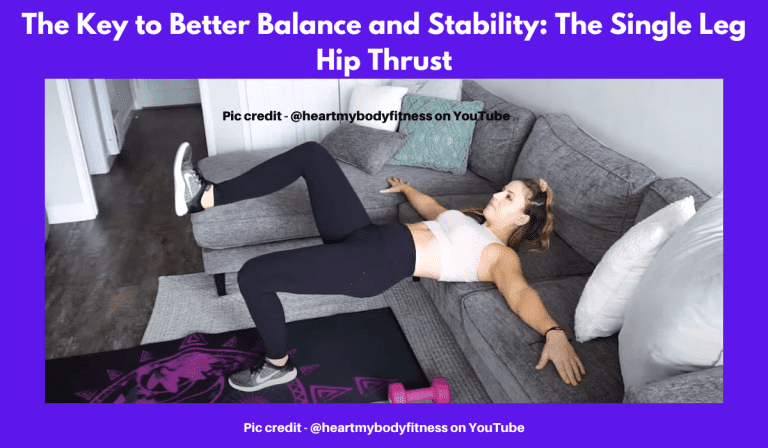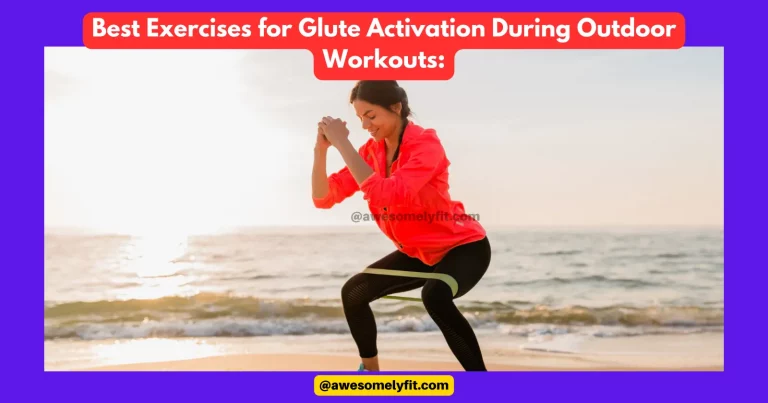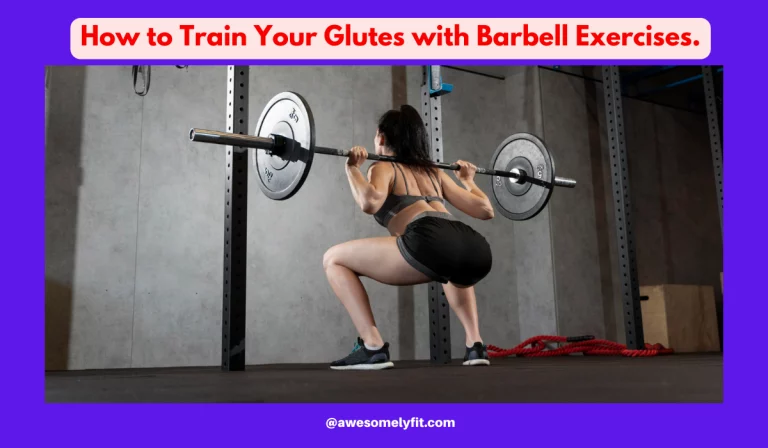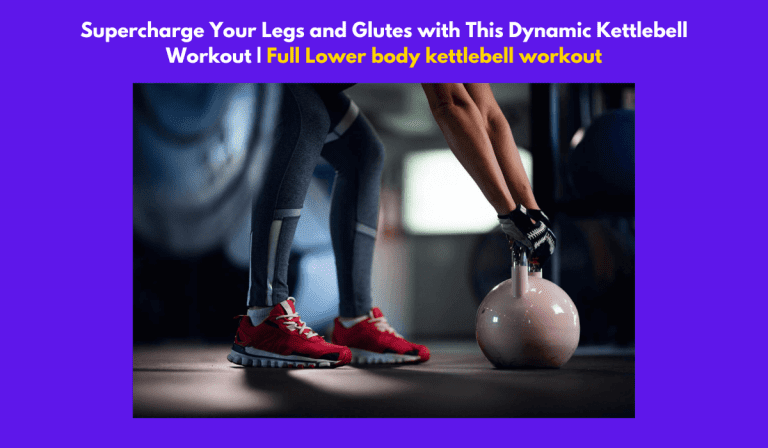How to Train Glutes without Quads: Tips for a Toned Butt
Are you tired of traditional leg workouts that focus solely on your quadriceps, leaving your gluteus maximus feeling neglected? If you’re looking to build a strong and shapely lower body without relying solely on quad-dominant exercises, we’ve got you covered. Training your glutes without engaging your quads can be challenging, but it’s crucial for toned butt and overall lower body strength.
Concentrated glute workouts are key for achieving a toned butt. But how do you effectively train your gluteal muscles while minimizing quad activation? Incorporating hamstring exercises can help target the gluteus maximus and strengthen the gluteal muscles.
By incorporating resistance band exercises, focusing on posterior chain movements, and adopting specific modifications in your training program, you can lead yourself towards a more targeted approach for developing strong gluteal muscles. So get ready to say goodbye to quad dominance and hello to a rounder backside! Check out our instructional video below for guidance on how to tone your butt without neglecting your quadriceps with leg extensions.
Exercises to grow glutes without increasing leg size
If you’re looking to build your glute muscles without adding bulk to your legs, there are several effective exercises that can help you achieve this goal. By focusing on isolating and targeting the glutes specifically, while avoiding compound movements that heavily engage the quadriceps, you can sculpt and strengthen your glutes without increasing leg size. Incorporating hack squats, calf raises, and adductor exercises with low reps can also enhance your results.
Effective exercises that isolate and target the glute muscles specifically
To effectively train your glutes without engaging the quadriceps too much, it’s important to choose exercises that primarily target the glute muscles. Here are some examples of such exercises: leg press, leg extension, and other exercises that focus on the legs.
- Glute bridges: Lie on your back with knees bent and feet flat on the ground. Lift your hips off the floor by squeezing your glutes until your body forms a straight line from shoulders to knees.
- Donkey kicks: Start on all fours with hands directly under shoulders and knees under hips. Keeping one knee bent at a 90-degree angle, lift it up towards the ceiling while keeping the rest of your body stable.
- Fire hydrants: Begin in a tabletop position with hands directly under shoulders and knees under hips. Lift one leg out to the side while maintaining a 90-degree angle at the knee.
- Clamshells: Lie on one side with knees bent and feet together. Keeping your feet touching, open your top knee as far as possible while maintaining contact between both feet.
By incorporating squat exercises into your routine, you can effectively target and activate your glute muscles without heavily engaging the quadriceps. Use the appropriate load and perform enough reps to see results.
Avoiding compound movements that heavily engage the quadriceps
Compound movements such as squats and lunges are excellent for overall lower body strength but tend to engage both quads and glutes simultaneously. If you want to focus more on your glutes and minimize quad engagement, consider modifying these exercises or replacing them with alternatives that isolate the glute muscles. When performing squats and lunges, adjust the reps, load, and use variations to target your glutes specifically.
Instead of traditional squats, try:
- Sumo squats: Stand with feet wider than shoulder-width apart and toes pointed slightly outward. Squat down by bending your knees while keeping your back straight.
Instead of regular lunges, try:
- Reverse lunges: Step backward with one foot and lower your body until both knees are bent at a 90-degree angle. Push through the front heel to return to the starting position.
By modifying your squat technique, you can target your glutes more effectively during leg exercises. This involves adjusting your reps and load to minimize quad activation.
Incorporating resistance bands and hip thrust variations for optimal results
To further enhance your glute training and stimulate muscle growth without increasing leg size, incorporating resistance bands, squats, and hip thrust variations into your routine is highly beneficial. Here’s how you can use squats, reps, load, and resistance bands to do it.
- Resistance band exercises: Wrap a resistance band around your thighs or just above your knees during glute-focused exercises like bridges or clamshells. The added resistance will intensify the workout for your glute muscles.
- Hip thrust variations: Experiment with different hip thrust variations to target specific areas of the glutes. Try single-leg hip thrusts or banded hip thrusts using a barbell or dumbbells for added resistance.
Best glute-building exercises for a sculpted rear
Building strong and shapely glutes is a goal for many fitness enthusiasts. However, if you’re looking to train your glutes without engaging your quads too much, there are specific exercises that can help you achieve just that. Let’s explore some of the best glute-building exercises that primarily activate the glutes while minimizing quad involvement. One such exercise is the squat, which is great for targeting the glutes. By increasing the number of reps you do, you can really challenge your glutes and see results. Another exercise to consider is the use of resistance bands, which can help intensify the glute workout.
Squat variations that primarily activate the glutes while minimizing quad involvement
Sumo squats are renowned leg exercises for targeting the lower body, as they specifically target the glutes while reducing quad activation. By taking a wide stance with toes pointed outward, you can use sumo squats to place more emphasis on the inner thighs and outer glutes, helping to sculpt your rear without overworking your quads. Aim for a specific number of reps to maximize the effectiveness of this exercise.
Another effective leg exercise variation is the goblet squat. Holding a dumbbell or kettlebell close to your chest, perform squats with a narrower stance than usual for optimal results. This modification shifts focus onto the posterior chain muscles, including the glutes and hamstrings, allowing you to build strength and shape in these areas without excessive quad engagement. Aim for a higher number of reps to maximize the benefits of this exercise.
Lunges and step-ups with modifications to emphasize glute activation
Lunges and step-ups are excellent compound exercises that engage multiple muscle groups simultaneously. To maximize glute activation while minimizing quad involvement during lunges, try performing reverse lunges instead of forward lunges. Stepping backward emphasizes hip extension rather than knee flexion, placing more emphasis on the glutes. Adding reps can increase the intensity and effectiveness of these exercises.
For step-ups, choose a higher platform or bench to increase hip extension range of motion. By stepping up onto an elevated surface with one leg at a time, you’ll effectively target your glutes while limiting quad engagement. This exercise is great for building strength and endurance in your glutes and quads. Aim for 10-12 reps per leg for optimal results.
Hip abduction exercises to strengthen and shape the outer glutes
Hip abduction exercises isolate and strengthen the outer hip muscles responsible for shaping those coveted side-glutes. One effective exercise is the standing hip abduction. Stand upright and lift one leg out to the side, focusing on squeezing the glute muscles throughout the movement. You can add resistance by using a resistance band or ankle weights for an extra challenge.
Another great option is the clamshell exercise. Lie on your side with your knees bent and feet together. Keeping your feet touching, lift your top knee as high as possible while maintaining tension in the glutes. This exercise targets the gluteus medius, which helps create definition and shape in the outer glutes.
Incorporating these glute-building exercises into your workout routine will help you sculpt a rear end that turns heads without overworking your quads. Remember to perform each exercise with proper form and gradually increase intensity by adding resistance or increasing repetitions over time. With consistency and dedication, you’ll be well on your way to achieving strong and shapely glutes!
Tips for targeting glutes while minimizing quad activation
There are several pro tips you can follow. By focusing on proper form and technique, adjusting foot placement and range of motion, and incorporating lighter weights or bodyweight exercises, you can effectively target your glutes while minimizing quad activation.
Proper form and technique for maximum engagement
To ensure maximum engagement of the glute muscles during your workouts, it is crucial to maintain proper form and technique. This involves activating the glutes intentionally throughout each exercise and avoiding compensatory movements that rely heavily on the quads.
One key aspect of proper form is maintaining a neutral spine alignment. Engage your core muscles by pulling your belly button towards your spine, which helps stabilize the pelvis and prevent excessive quad recruitment. Focusing on a controlled tempo during exercises allows for better mind-muscle connection with the glutes.
Adjusting foot placement and range of motion
Another effective strategy to target the glutes while minimizing quad activation is by adjusting foot placement and range of motion in various exercises. By altering these factors, you can shift the emphasis away from the quads and onto the glute muscles.
For example:
- In squats: Widen your stance slightly beyond shoulder-width apart with toes pointed outward to activate more gluteal muscles.
- In lunges: Take longer strides forward or backward to increase hip extension and engage the glutes further.
- In glute workout step-ups: Place more weight onto your heel rather than relying on pushing off with your toes to minimize quad involvement.
Remember that everyone’s biomechanics may vary slightly, so experiment with different foot placements and ranges of motion to discover what works best for you.
Using lighter weights or bodyweight exercises
To specifically isolate the glute muscles without overworking the quads, incorporating lighter weights or bodyweight exercises can be highly effective. By reducing the load on your quads, you can focus more on engaging and targeting the glutes.
Here are some exercises to consider:
- Glute bridges: Lie on your back with knees bent and feet flat on the ground. Lift your hips off the floor, squeezing your glutes at the top of the movement.
- Donkey kicks: Start on all fours and lift one leg straight back while keeping it bent at a 90-degree angle. Squeeze your glutes as you lift.
- Clamshells: Lie on your side with knees bent and ankles together. Open and close your knees like a clamshell, focusing on engaging the glute muscles.
By incorporating these lighter weight or bodyweight exercises into your routine, you can effectively target and strengthen your glutes while minimizing quad activation.
Strengthening glutes without bulking up thighs
Many individuals are concerned about avoiding excessive growth in their thighs. While strong and toned glutes are desirable, some people prefer to maintain a more streamlined look in their legs. Fortunately, there are strategies that can help you strengthen your glutes without bulking up your thighs.
Balancing volume, intensity, and frequency of workouts
To avoid quad development while focusing on hypertrophy in the glutes, it’s important to strike a balance between volume, intensity, and frequency of your workouts. This means carefully selecting exercises and adjusting variables to target the glute muscles while minimizing stimulation to the quadriceps.
One effective exercise for targeting the glutes is the glute bridge. This movement primarily activates the posterior chain and can be performed with bodyweight or added resistance such as dumbbells or barbells. By emphasizing proper form and engaging the glutes throughout each repetition, you can maximize muscle recruitment in this area.
Incorporating high-repetition sets and shorter rest periods
Another strategy for training the glutes without excessive quad growth is incorporating high-repetition sets and shorter rest periods into your routine. This approach focuses on building muscle endurance rather than sheer strength or size.
For instance, performing lunges with lighter weights for higher repetitions can help activate the glute muscles while minimizing quad involvement. By keeping rest periods shorter between sets (around 30-60 seconds), you can increase metabolic stress on the targeted muscles without allowing sufficient recovery time for significant thigh growth.
Alternative exercises that target the glutes
In addition to traditional exercises like squats and lunges which may engage both quads and glutes simultaneously, there are alternative movements that specifically target the gluteal muscles without heavily involving the thighs:
- Hip thrusts: This exercise isolates the hip extensors (glutes) by placing the upper back against a bench and driving through the heels to lift the hips. It can be performed with bodyweight, dumbbells, or barbells.
- Bulgarian split squats: By elevating one foot on a bench or step behind you, this exercise places more emphasis on the glutes while minimizing quad activation.
- Sumo squats: Taking a wider stance with toes pointed outward targets the glutes more than traditional squats.
Remember to focus on mind-muscle connection and proper form during these exercises to ensure maximum activation of the glute muscles.
Activating and isolating glutes effectively
There are several techniques and exercises that can help you achieve your goal. By highly activating and isolating your glutes, you can focus on developing these muscles while minimizing quad engagement.
Pre-workout warm-up routines specifically designed to activate the glute muscles
Before diving into your main workout, it’s essential to prepare your glutes for optimal activation. Incorporating specific warm-up exercises can help activate these muscles and ensure they’re firing properly during your training session. Here are some pre-workout warm-up routines that target the glutes:
- Foam rolling: Begin by using a foam roller on your glutes, hamstrings, and adductors to release any tension or tightness in these areas.
- Glute bridges: Lie on the floor with knees bent and feet flat on the ground. Lift your hips off the floor while squeezing your glutes at the top of the movement.
- Clamshells: Lie on one side with knees bent and feet together. Open and close your legs like a clamshell while keeping tension in your glutes.
By incorporating these warm-up exercises into your routine, you’ll prime your glutes for maximum activation during your workout.
Mind-muscle connection techniques for better control over targeted muscle engagement
Developing a strong mind-muscle connection is crucial when trying to isolate specific muscle groups such as the glutes. This technique allows you to consciously engage and contract those muscles throughout each exercise. Here’s how you can improve this connection:
- Focus on form: Pay attention to proper form during each exercise, ensuring that you’re engaging primarily with your glute muscles rather than relying on other muscle groups.
- Visualize the movement: Before performing an exercise, visualize the targeted muscle group working and contracting with each repetition.
- Slow down the movements: By slowing down your reps, you can increase your awareness of the muscles being used and focus on maintaining tension in your glutes throughout the exercise.
By incorporating these mind-muscle connection techniques into your training routine, you’ll enhance your ability to isolate and engage your glutes effectively.
Utilizing single-leg exercises to enhance isolation and balance between both sides
Single-leg exercises are excellent for isolating the glutes while also addressing any strength imbalances between both sides of your body. These exercises require more stability and control, forcing each glute to work independently. Here are some single-leg exercises you can incorporate into your workout:
- Single-leg hip thrusts: Sit on the floor with one foot flat on the ground and another leg extended straight out. Lift your hips off the floor using only the grounded foot while squeezing your glute at the peak contraction.
- Bulgarian split squats: Stand facing away from a bench or step with one foot elevated behind you. Lower yourself into a lunge position by bending your front knee while keeping tension in your glutes.
- Single-leg deadlifts: Stand on one leg while holding a dumbbell or kettlebell in one hand. Hinge forward at the hips, extending your free leg backward for balance until you feel a stretch in your hamstrings.
Building strong glutes with minimal thigh involvement
There are several effective strategies you can implement. By focusing on exercises that target the posterior chain, such as deadlifts, hip hinges, and back extensions, you can maximize hamstring and glute activation while minimizing quad involvement.
Prioritizing hamstring and glute activation
Implementing exercises that prioritize hamstring and glute activation over quad engagement is key to training your glutes without relying heavily on your thighs. Deadlifts are an excellent compound movement that targets multiple muscle groups, including the hamstrings and glutes. By performing deadlifts with proper form and technique, you can effectively activate these muscles while minimizing quad recruitment.
Hip hinges are another great exercise for targeting the posterior chain. This movement pattern involves bending at the hips while keeping a slight bend in the knees. Examples of hip hinge exercises include Romanian deadlifts (RDLs) and kettlebell swings. These exercises primarily engage the hamstrings and glutes, helping to develop strength in these areas without putting excessive strain on the quads.
Back extensions also play a significant role in activating the hamstrings and glutes while minimizing quad involvement. This exercise involves lying face down on a hyperextension bench or stability ball and lifting your upper body off the ground by contracting your lower back muscles. Back extensions isolate the posterior chain muscles, making them an effective addition to any glute-focused workout routine.
Stability ball exercises for core stability
Incorporating stability ball exercises into your training routine not only challenges core stability but also engages the posterior chain muscles, including the glutes and hamstrings. These exercises require balance and coordination, forcing your body to recruit more muscle fibers from these targeted areas.
One example of a stability ball exercise that targets both core stability and activates the posterior chain is using a stability ball for hamstring curls. Start by lying on your back with your feet resting on the ball. Lift your hips off the ground and roll the ball towards you, bending your knees and engaging your hamstrings. This exercise effectively isolates the glutes and hamstrings while minimizing quad involvement.
Isolating the glutes effectively
To specifically target and isolate the glutes, exercises like glute bridges and single-leg hip thrusts are highly effective. Glute bridges involve lying on your back with your knees bent and feet flat on the ground. Lift your hips off the ground, squeezing your glutes at the top of the movement. This exercise primarily targets the gluteus maximus, helping to develop strong and shapely glutes without putting excessive strain on the thighs.
Single-leg hip thrusts are a more advanced variation of glute bridges that further isolate each side of the glutes individually. By performing this exercise unilaterally, you can ensure balanced development between both sides while minimizing quad involvement.
Conclusion
To achieve glute strength without quad dominance, it is important to focus on exercises that target the glutes while minimizing activation of the quads. By incorporating specific techniques and workouts, you can effectively build strong glutes without bulking up your thighs.
Here are some key points to keep in mind:
- Exercises to grow glutes without increasing leg size: Look for exercises that isolate and activate the glute muscles, such as hip thrusts, glute bridges, and donkey kicks. These movements specifically target the glutes while minimizing quad involvement.
- Best glute-building exercises for a sculpted rear: Incorporate exercises like squats with a wide stance, lunges with a posterior emphasis, and cable kickbacks. These exercises help develop a well-rounded and sculpted rear end.
- Tips for targeting glutes while minimizing quad activation: Focus on proper form and technique during your workouts. Engage your core muscles, maintain a neutral spine, and avoid excessive knee flexion to ensure maximum glute activation.
- Strengthening glutes without bulking up thighs: By selecting exercises that primarily engage the glute muscles rather than relying heavily on quads, you can prevent excessive thigh muscle growth while still building strong and shapely glutes.
- Activating and isolating glutes effectively: Incorporate resistance bands or ankle weights into your workouts to add extra resistance and increase the intensity of your exercises. This can help further activate and isolate the glute muscles.
- Building strong glutes with minimal thigh involvement: Implement high-repetition sets with lighter weights to fatigue the targeted muscles without putting excessive strain on your thighs.
By following these guidelines and focusing on targeted exercises for your glutes, you can achieve stronger and more defined buttocks without overdeveloping your quads.
Now it’s time to take action! Incorporate these tips and exercises into your workout routine, and you’ll be on your way to achieving the glute strength and shape you desire.
FAQs
Can I train my glutes without involving my quads?
Yes, it is possible to train your glutes without heavily involving your quads. By selecting specific exercises that target the glute muscles while minimizing quad activation, you can focus on developing strong glutes without bulking up your thighs.
What are some effective glute-building exercises?
Some effective glute-building exercises include hip thrusts, glute bridges, squats with a wide stance, lunges with a posterior emphasis, cable kickbacks, and donkey kicks. These movements specifically target the glute muscles and help sculpt a well-rounded rear end.
How can I minimize quad activation during glute workouts?
To minimize quad activation during glute workouts, focus on maintaining proper form and technique. Engage your core muscles, keep a neutral spine position, and avoid excessive knee flexion. This will ensure maximum activation of the glutes while minimizing quad involvement.
Will training my glutes make my thighs bigger?
By selecting exercises that primarily engage the glute muscles rather than relying heavily on quads, you can prevent excessive thigh muscle growth while still building strong and shapely glutes. With proper exercise selection and technique, you can achieve a balanced physique without overly bulky thighs.
How can I increase the effectiveness of my glute workouts?
To increase the effectiveness of your glute workouts, consider incorporating resistance bands or ankle weights to add extra resistance. This will intensify the exercises and further activate and isolate the targeted muscles for optimal results.
Remember to consult with a fitness professional or trainer for personalized advice based on your individual goals and physical condition.

👋 I am Rakesh Sonawane, a personal trainer with around half a decade of working experience. I have been fortunate enough to have trained people from all walks of life.
I created this site to simplify the path of getting fit and healthy as the internet is filled with too complex and useless info.
My website content is well-planned, thought, and well-researched before being published on the site for you to read. Hopefully, you will enjoy my helpful, practical content.






